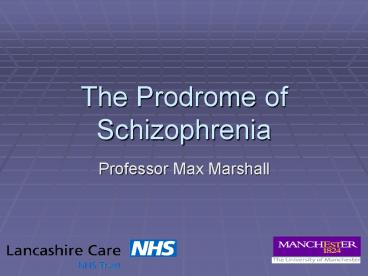The Prodrome of Schizophrenia - PowerPoint PPT Presentation
1 / 30
Title:
The Prodrome of Schizophrenia
Description:
Social Deterioration is a key aspect of the prodrome. If there is no social deterioration it is questionable whether the prodrome is present ' ... – PowerPoint PPT presentation
Number of Views:737
Avg rating:3.0/5.0
Title: The Prodrome of Schizophrenia
1
The Prodrome of Schizophrenia
- Professor Max Marshall
2
Overview
- What is the prodrome?
- How can it be detected?
- What do we do in the LEAD clinic?
- Development of LEAD clinics
3
(No Transcript)
4
Prodromal Symptoms
- Two phases in emergence
- Pre-psychotic
- Non- specific dep/anx/restless/conc/worry/self
conf/energy - Specific basic symptoms
- Sub-psychotic
- BLIPS and Attenuated Symptoms
5
Social Deterioration
- Social Deterioration is a key aspect of the
prodrome - If there is no social deterioration it is
questionable whether the prodrome is present - Decay not drift - social deterioration
follows symptoms
6
Onset of Social Disabilities (from IRAOS scale)
7
How do we detect it?
- State-Trait Approaches
- i.e. Risk factors plus deterioration
- Specific non-psychotic symptoms
- Basic symptoms
- Sub-psychotic symptoms
- Brief limited psychotic symptoms
- Attenuated psychotic symptoms
8
STATE-TRAIT APPROACHES
- Genetic loading
- Soft signs
- Schizotypy
- PLUS
- Social deterioration
9
Soft Neurological Signs
- Neurological soft signs (NSS) are minor
neurological signs indicating non-specific
cerebral dysfunction. - Patients with first-episode psychosis show an
excess of NSS, particularly in motor coordination
and sequencing, sensory integration and in
developmental reflexes.
10
Soft Neurological Signs
11
Schizotypy
- DSM IV Axis II disorder
- Present in 1-3 of population
- Associated increased rate schizophrenia (20-40)
- Present in families of people with psychosis
- Some traits analogous to psychotic symps
- Assessed by SPQ (Raine)
12
Elements of Schizotypy
- Cognitive Perceptual
- magical thinking, unusual perceptual experiences,
ideas of reference, paranoid ideation - Interpersonal
- no close friends, constricted affect, undue
social anxiety - Disorganised
- odd/eccentric behaviour, odd speech
13
Basic Symptoms (Huber)
- Subtle, sub-clinical, subjective disturbances in
drive, stress tolerance, affect, thinking,
speech, perception motor actions - Phenomenologically distinct from psychotic
symptoms - An early expression of somatic disturbance
underlying development of psychosis - Measured using SPI-A (Schizophrenia Proneness
Instrument Adult version)
14
Thought Perseveration
15
Disturbance of Receptive Language
16
Unstable Ideas of Reference
17
Acoustic Perception Disturbances
18
ROC curves of ten best symptoms in a model
validation sample (n80 / 80)
19
At Risk Mental States
- Alison Yung Pat McGorry
- Comprehensive Assessment of At Risk Mental States
(CAARMS) - SIPS/SOPS
- Brief Limited Intermittent Psychotic Symptoms
(BLIPS) - Of psychotic intensity but limited duration
- Attenuated Psychotic Symptoms
- Of sub-psychotic intensity
20
(No Transcript)
21
Effectiveness of Early Detection
- State-Trait Approaches
- Not all patients have them if no deterioration
does not predict immediate risk - ARMS
- Short range prediction only already almost
psychotic - SPI-A long range
- Promising, but no gold standard study
- No formal synthesis of diagnostic studies
22
The LEAD Clinic
- Mike Fitzsimmons, Kishen Neelan, Caroline
Johnson, myself - Running for 18 ms, Daisyfield CMHT
- Assess service users who are not psychotic but
might have prodromal symptoms
23
Purpose of the clinic
- To see if it was feasible
- To assess demand and service user and carers
reactions - To train ourselves and refine our assessments
- To understand how it might contribute to the EIS
24
The LEAD Assessment
- Genetic Risk
- Schizotypy (SPQ)
- Deterioration (Cornblatt scales)
- Soft Signs (Neurological Rating Scale)
- Basic Symptoms (SPI-A)
- Attenuated/BLIPS (CAARMS)
25
Findings so far
- So far seen 34 service users
- About half are clearly prodromal, though to
different degrees of risk - Although the assessments takes 3 hours no one has
yet failed to complete it
26
Why bother?
- Access
- We need a quick process for identifying people in
the prodrome - Safety
- We have to show that decisions not to accept have
a sound/defensible basis - Resource Management
- We need to match the level of input to the level
of risk - We need to be able to discharge
27
Why have a clinic?
- Efficiency
- More than one person is required
- The assessments are difficult and highly
structured - Supervision and quality control is essential
- Accuracy
- Requires a quiet and controlled ambience
- Training and development
- Easier to bring in new or techniques
28
How could we make it better?
- Should embed clinics in the service
- We should extend the clinic to assess all
non-psychotic service users - Should do follow up at one year and discharge if
improved - Should have a stepped care model so only highest
risk are taken on by service - Should extend remit to assess all complex cases
29
Working group
- Set up a LEAD clinic working group
- Warren, Jeff, Faith, Alison, Mike, Imran
- Agreed to roll out LEAD clinics across EIS
- Developing an operational policy
- Training program
- IT support
- Service Evaluation
- Examining Admin Support
30
The End































